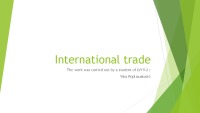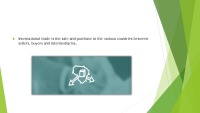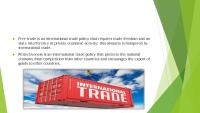International Trade Slides



International trade. International trade is the sale and purchase in the various countries between sellers. Free trade is. Four main sources. It often comes. The main measures protecting the national market from foreign competition are customs and quotas. Customs has the. Another measure of protectionist international trade policy is the quota. International trade policy forms sometimes include dumping and embargoes. An export subsidy is the amount paid by the country to its exporters.
International trade is the sale and purchase in the various countries between sellers, buyers and intermediaries.
Free trade is an international trade policy that requires trade freedom and no state interference in private economic activity; this obstacle is hampered by international trade. Protectiveness is an international trade policy that protects the national economy from competition from other countries and encourages the export of goods to other countries.
Four main sources of foreign trade benefit are distinguished: Increased competition - forces domestic producers to apply technical innovations, encourage lower costs and prices for goods, and improve their quality; The abundance and diversity of goods produced - in the context of international trade, it is possible to have more goods than countries could have if they produce goods themselves and only to their own citizens. Economies of scale - the expansion of the market through foreign trade allows manufacturers to manufacture goods at significantly higher volumes, to reduce production costs and prices or to produce goods that they have not paid for due to insufficient domestic demand; Comparative (relative) advantage - an advantage gained by a separate producer (country, region, city, business enterprise or individual), producing only a certain product if it can produce it relatively cheaply, i.
- Economy & Finance Presentations
- MS PowerPoint 1255 KB
- 2018 m.
- English
- 10 pages (793 words)
- College
- Vika
















